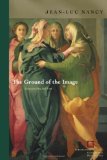

 |

|

The average rating for The ground of the image based on 2 reviews is 4.5 stars.
Review # 1 was written on 2013-07-20 00:00:00 Liat Blumberger Liat BlumbergerNancy's exploration of the image in relationship to the sacred feels slightly uneven compared to the other two books of his I've read ("Listening" and "The Fall of Sleep"). Two of the nine chapters -- the first, "The Image -- The Distinct", and the fifth, "Distinct Oscillation", contain some of my favorite writing of his, while the rest of the book hits a combination of high and low notes for my tastes. One of those high notes is his critique of violence in chapter two, which becomes so impassioned that his language becomes as coarse as the violence he seeks to shun; similarly, his keen eye for compositional analysis shines in the chapter eight's analysis of a painting of the Visitation by Pontormo. The low notes tend to come in what I can only describe as needlessly murky writing, as in the meandering exploration of visual Nazism in chapter three, "Forbidden Representation." But when Nancy is at his best, he positively soars. Chapter one is a barrage of intriguing ideas, challenging the accepted notions of what images are and do, with one wonderful turn of phrase after the other. In arguing that the Image is not a representation of a thing, or even a thing itself, but rather something distinct from reality, Nancy makes statements like "The image is thus its own sky, or the sky detached for itself, coming with all its force to fill the horizon but also to take it away, to lift it up or to pierce it, to raise it to an infinite power" (p. 6). And while the technique might at times seem to be clever for cleverness' sake, I can't help but admire the way he twists a statement into its opposite, creating verbal chiasms ("Art marks the distinctive traits of the absenting of truth, by which it is the truth absolutely" p. 13) that illustrate his ideas of the twisting interconnectedness of images and their nontraditional functions. It's in chapter five, "Distinct Oscillation," that Nancy reaches his highest peaks and, frustratingly, his lowest valleys. The most image-like text of the book (using playing card symbols as idea markers, splitting blocks of text down the middle to create a, dare I say it, uncanny valley in the midst of his ideas), it contains some of the most substantial and complex ideas in the book ("Can a text on a text [an interpretation, a commentary] and the image of a text [the painting of a book, of a letter] be interchanged? Does the text make an image of the text it interprets? Does the image become a text on the text that it, too, interprets?" p. 64). Yet when the chapter turns to a discussion of visual art images interacting with text, he discusses examples of nearly every kind of art but the most appropriate one: comics. It's hard to tell if this omission is due to oversight, lack of knowledge, or bias against comics as an art form, but I have a feeling that a lot of his conclusions would be substantially different were comics included in the mix. Then there are the few moments where Nancy writes with an almost deliberate sense of shocking the reader for the sake of it, throwing away deeply held notions in order to make what feels like revolutionary points -- but how can anyone seriously believe him when he states that "Art never commemorates. It is not made to preserve a memory, and whenever it is set to work in a monument, it does not belong to the memorializing aspect of the work" (p. 108)? He uses this notion as a connection to the concept of "immemory," a neologism originally coined on a 1998 cd-rom by experimental filmmaker Chris Marker, and while I've not experienced Marker's piece, if it is based on this same notion that art can never commemorate, I have a feeling I might be wary of its conclusions as well. Even with my reservations about some of the ideas here, I still think "The Ground of the Image" is a useful read to anyone interested in images, sound, memory, or spirituality. |
Review # 2 was written on 2018-04-06 00:00:00 Seth Graham Seth GrahamPretty wild little collection of essays (each chapter seems to stand alone) about image theory. I like Nancy's style, even though it's the annoying french style of philosophy as poetry. Also of course no feminist analysis or awareness. Recommend to pair with Sontag's On Photography. But got me thinking deep thoughts about representation, reference, semiotics, symbolic power, and the sacred. Hard to articulate how exactly I can apply this, but feels like it gave me a new lens to approach my studies. |
CAN'T FIND WHAT YOU'RE LOOKING FOR? CLICK HERE!!!